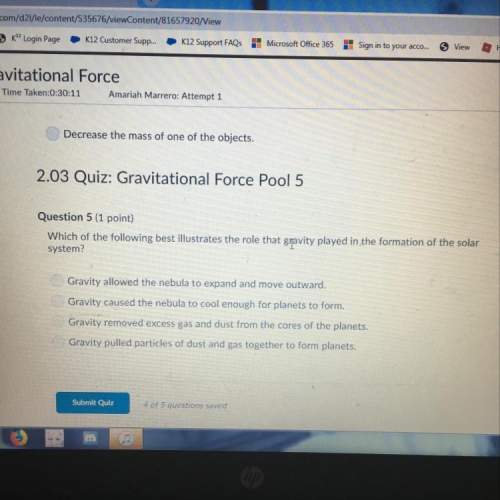
The law of conservation of mass states that in a chemical reaction, mass is neither created nor destroyed. that means, the total mass for the reactants needed to equal the total mass of the products. the reactants for photosynthesis are 6 carbon dioxide, 6 water and sunlight. the mass of these reactants adds to equal the mass of the products, which are 1 glucose and 6 oxygen. there are equal amounts of each atom on both sides of the chemical equation. the law of conservation of energy states that energy cannot be created nor destroyed. this is a little more confusing because energy (sunlight) is a reactant in the equation and not a product, so it had to go somewhere. energy can be converted from one form to another. in the case of photosynthesis, energy is converted from sunlight into glucose. glucose is a carbohydrate which is a molecule that the body can break down for energy.

Answers: 2


Another question on Chemistry

Chemistry, 21.06.2019 23:00
Write a brief passage describing a neutral atom of nitrogen-14 (n-14). describe the number of protons, neutrons, and electrons in the atom, where each type of particle is located, and how the terms atomic number, mass number, and atomic mass are related to the particles. use the periodic table to you. 14 protons and eletrons since its a neutral atom
Answers: 1

Chemistry, 22.06.2019 05:40
Salicylic acid is a very important acid. it is used to synthesize the aspirin by treating with acetic anhydride. a 0.2015-g sample of salicylic acid was dissolved in a 100.00-ml volumetric flask, and the solution was diluted to the mark. a 10-ml aliquot of this solution was titrated with standard naoh (0.01130 + 0.2% n) to a phenolphthalein faint pink color end point at 19.81 ml. (a) (calculate the normality of the salicylic acid solution used in the titration. (b) assuming the salicylic acid is pure, what is the equivalent weight of the salicylic acid? practice problems for the final exam (continued) (c) (calculate the inherent error in the determination of the equivalent weight you calculated in part (b). use the following absolute errors in the equipment /glassware when calculating the inherent error. 5.00-ml pipet: + 0.02 ml 100-ml volumetric flask: + 0.08 ml analytical balance: + 0.2 mg 25-ml buret: + 0.03 ml
Answers: 2

Chemistry, 22.06.2019 07:30
Given that 1 mi = 1760 yd, determine what conver- sion factor is appropriate to convert 1849 yd to miles; to convert 2.781 mi to yards.
Answers: 2

Chemistry, 22.06.2019 19:30
Draw the lewis structure for the trisulfur s3 molecule. be sure to include all resonance structures that satisfy the octet rule.
Answers: 3
You know the right answer?
The law of conservation of mass states that in a chemical reaction, mass is neither created nor dest...
Questions

English, 04.04.2020 06:24



English, 04.04.2020 06:24

Biology, 04.04.2020 06:24

Mathematics, 04.04.2020 06:24

Biology, 04.04.2020 06:24



Computers and Technology, 04.04.2020 06:25

English, 04.04.2020 06:25

Mathematics, 04.04.2020 06:25




Chemistry, 04.04.2020 06:26


Mathematics, 04.04.2020 06:26

Mathematics, 04.04.2020 06:26





